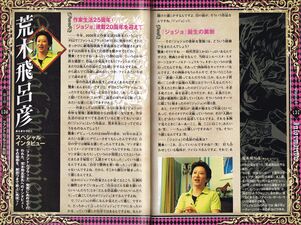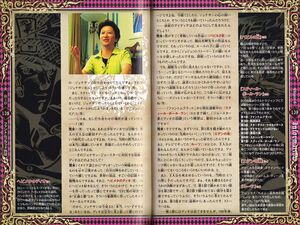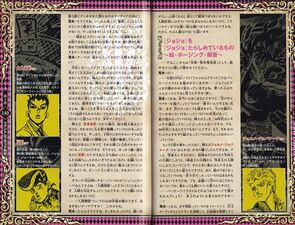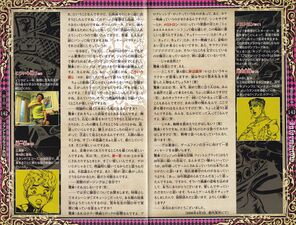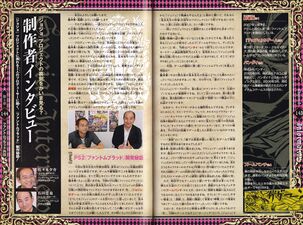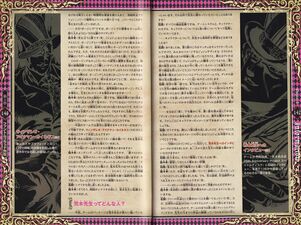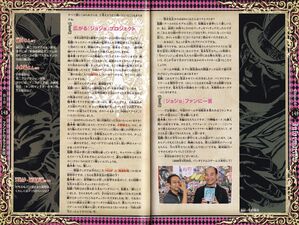Phantom Blood PS2 (October 2006)
Tokai Lecture (June 2006)
Interview Archive
Interviews with Hirohiko Araki, and Bandai Namco staff members Yusuke Sasaki and Chuya Ishida.
The interview with Hirohiko Araki was originally released as part of the pre-order bonus disc for the Phantom Blood PS2 game. The Bandai Namco staff interview was released in the Omniscience and Omnipotence Book strategy guide published by V Jump, along with a different edit of the interview with Araki.
Interviews
Interview with Hirohiko Araki
Hirohiko Araki
Special Interview
An interview with Hirohiko Araki held alongside the release of Phantom Blood. That interview has been reproduced on paper with notes!
This year, 2006, marks the 25th anniversary of your career as an artist. Phantom Blood will also be released on the PlayStation 2 in October, shortly followed by a feature film and an exhibition of your original artwork. To begin with, please tell us your thoughts regarding your 25th anniversary.
Araki: Well, well... Honestly, it feels like 25 years flew by in the blink of an eye. When I look back at my own work, Phantom Blood feels as though it was drawn by somebody else. So I can read it quite acutely, or rather, as if I were a fan.
Do you reread your older works often?
Araki: I don't do it often. But when it becomes a game like this one, I take a quick look through it and think, "Oh, so that's what I drew" (laughs). Though, it feels like the readers know more about it than I do.
You're celebrating your 25th anniversary as an artist, and next year will mark the 20th anniversary of the start of JoJo's Bizarre Adventure's serialization. Being a work that's taken up almost your entire career as an artist, what does JoJo mean to you, Araki?
Araki: I made my debut at the very end of 1980, or possibly on New Year's Day in 1981, but it all felt rather vague to me back then. I didn't have a clear image of myself as a manga artist, and I didn't have a good answer to the question of, "What kind of manga artist am I?" It felt as though I just happened to be selected for the Tezuka Award[A 1] by chance. It didn't feel like I took home the victory by myself. So I feel like my training started from that point onward.
When I looked at other Jump artists, I thought they had such an overwhelming sense of individuality. I kept wondering what kind of pictures to draw and what kind of work to create until JoJo. It felt like JoJo gave me a glimpse of that. So, if anything, I feel as though JoJo made me a professional. It felt as though something had opened ahead of me. That's the kind of work JoJo is.
How did the idea of JoJo's Bizarre Adventure take root?
Araki: Hmm... There's a lot of historical background and details like that, but mainly, I liked movies, and at the time Sylvester Stallone and Arnold Schwarzenegger were popular. They were "physical characters," so to speak. Their bodies were so muscular, and that made me think, "Who's the strongest person in the world?" And then, being a child, "What kind of person is the strongest person in the world?" That was when JoJo began. Topics like immortality, the pursuit of life, and later justice. Part 1 of JoJo started out as an attempt to depict, as the theme, the things that humans pursue on a fundamental level.
Also, I went on a trip to Italy about two years beforehand (before the serialization began), and the art there sought to depict things like "human beauty." When I saw the real works of art, it felt like, "Ah, this is it. I want to go there" (laughs)... Was that imprudent of me? But that's how it felt (laughs).
Where did the name JoJo come from?
Araki: ...Am I allowed to say this? (laughs) The place where I had meetings was a family restaurant. I think, maybe... the meetings were at Jonathan's? So we went, "Let's call him Jonathan or something." (laughs). Also, Steven Spielberg's name has "S" and "S," right? It's not quite a rhyme, but Jonathan could go with "J" and "J," so we said, "Let's call him Joestar or something." Thus, JoJo (laughs)!
Then, what would have happened if the meeting place were different... (laughs)?
Araki: Haha. But, you know, it was rather adventurous for a shonen manga, and a foreign protagonist was definitely taboo. That's just how that era was. So I'm very grateful to my editor at the time. Normally, they'd have told me to stop.
How did you create Dio, Jonathan Joestar's archnemesis?
Araki: There's an Italian word, "dio," which means something like "God." As though he sought to become a god, the pinnacle of the world. He's very confident and arrogant. And there's also the heavy metal Dio (laughs).[A 2] I like heavy metal. I suppose I must've created the character to represent that. He was a character that symbolized the confrontation between black and white, good and evil. For that reason, when I look at Jonathan now, I think, "He's just too nice." Dio is a complete picture of both light and darkness. If I had drawn Jonathan nowadays, I'd probably have depicted the weaknesses of Jonathan's spirit, and other similar aspects.
How did the idea of the Ripple come about?
Araki: I have a lot of respect for Mitsuteru Yokoyama's manga Babel II,[A 3] in which the fights unfold under certain rules. That's why I wanted the battles in JoJo's story to have rules as well. That's where the Ripple came in. But psychic powers are invisible, aren't they? You say, "Ugh...", and then the thing breaks with a bang, and you can't see any of it.
But I thought, "It's a manga, so surely I should be able to draw it." To make it easier for readers to understand, I wondered, "What kind of supernatural power is it, exactly?" and from there, I created it and called it the Ripple. It's like a ripple spreading, spreading gradually[A 4] like this... I swear that wasn't a bad pun, but it felt like one anyway (laughs).
Did you have the idea of the bond between the Joestar family and Dio, which continues from Phantom Blood up to the current serialization, Steel Ball Run, from the beginning?
Araki: I did. To begin with, back when I first started writing Part 1, I wanted to "start from the ancestors," so to speak. I liked that kind of thing in works like East of Eden.[A 5] And then there was Roots,[A 6] which aired on TV. The main character changed, but it just kept going. There are dramas like that in America, too. Usually, it's just, "let's just get to the present," so I didn't think it was very Jump-like, but I thought it might be good to go somewhere no one else has depicted before.
Also, killing off the main character was very taboo (at the time). Well, in any case, I had to take that into account from the beginning. So anything I couldn't draw in Part 1, I would draw in Part 2, and likewise whatever wasn't in Part 2 would end up in Part 3. That's what I thought, at least. The story was all there, (from the very beginning) all the way up to Part 3.
So even though Dio doesn't appear in Part 2, you had the idea of him reappearing 100 years later in Part 3?
Araki: That's right. I really wanted to depict him dying and then being resurrected. If there wasn't a bit of a gap, it wouldn't work out. Yes.
How was the process of switching from the Ripple to Stands?
Araki: I tried portraying psychic abilities through pictures with the Ripple, and I tried to do the same with Stands, but... How should I put it...? I wanted to have punches from here (away from the body). I had a meeting where I was asked, "What are you going to do next? You can't use the Ripple anymore." But when I said, "Well, a punch comes out of here (the front of the body) and breaks stuff," they were confused and didn't understand me at all. So I said something like, "How should I put this...? Well, there's something like a guardian spirit, and it comes out and attacks." That's how I explained what the new ability would be, and nobody understood what I was on about.
I told them that I thought I could create a lot of characters this way: I could make a green-colored punch or a sharp thing appear and make them fight. Unlike the Ripple, there were so many possibilities I could use. That's how I started with Stands, though I originally thought that people who read it wouldn't know what's going on at first. Stands gave me a lot of trouble when it came to explaining them, but I really felt that I could keep inventing new characters and ideas forever that way. It was like I dug up a gold mine. No one else thought it was gold, but for me, it was like, "Wow, look what I dug up!"
What were your ideas for Part 4 onward?
Araki: Part 3 was a story with the shape of a role-playing game. It was like a board game where you'd go here and there. There's a book called Around the World in Eighty Days, which was one of my influences for Part 3's story. From that premise, the enemies would have to be the type that come and attack Jotaro themselves, though they might be waiting for them too. So when I was thinking of ideas, I thought of people that were willing to wait at their posts for a long time, people that lived in houses and attack when customers arrive, people with personalities like spiders.
I had a lot of those ideas left over, so I thought I could probably use them within a single town. There were various incidents back then, such as a murder spree that sent huge shockwaves across Japan. The feeling of your neighbor possibly being a serial killer was the perfect atmosphere, so I used that idea when setting up lots of Stand users around the town. That's basically how Part 4 was born, and you can see how different it is from Part 3. Making Part 3 different to Part 2, and making Part 4 different to Part 3... That's how JoJo is made.
Up until Part 3, the setting was an imaginary, mythical kind of world, but for Part 4, I drew an everyday world. For that reason, I feel closer to Josuke, which is why I like him the most. I found it really fun to write. It was like he became a friend of sorts. Jotaro is more so someone that you admire, like a hero from a mythical tale. But Josuke seems more like a friend or a senior.
Even though Josuke's supposed to be an illegitimate child...?
Araki: Yes, exactly. If I could write more of Part 4, I'd like to explore that specifically. You would probably develop some complicated ways of thinking if you were an illegitimate child, and Josuke was also meeting his father for the first time, so I'd like to write more in depth about that. I really would like to, if I got the chance. Part 4 isn't really finished yet. If I decided to continue it one day, I could do it for as long as I wanted.
Why did you make the hero (of Part 5) DIO's son?
Araki: Oh, right. In Part 5, he's not really a blood relative... or, well, he sort of is. I find great importance in the upbringing and background of a characters. Things like what kind of place they were born into, and what their parents were like. If I know that, then it makes it easier to understand and depict them. For that reason, I find bloodlines very important. It might seem like a bit of a stretch, but that's where Part 5 started from. During Part 4, the editor said to me, "Are you able to draw sorrow?" But life is a sad thing in and of itself, though, isn't it? He asked me if I could draw that, and initially I said it wasn't really my style. But for Part 5, I suddenly felt the urge to draw just that: the sadness of being ostracized by society, but still having a sense of justice. That was what I tearfully wrote for Vento Aureo.
You once said (before Part 6) that you couldn't draw women.
Araki: Back then, it was unthinkable to have a female character taking punches, and in JoJo, arms can go flying if you're not careful. I felt that I wasn't able to draw that with female characters, and the readers wouldn't be able to keep up anyway. As I grew older, the difference between genders became less important, and I started to feel that I could actually draw a tough female. What I came up with was Stone Ocean, which takes place in a prison setting.
What about the end of Part 6?
Araki: A main villain in JoJo has to be incredibly strong. And I already made DIO stop time, so I figured the readers wouldn't be happy unless I thought of something even stronger. So I thought about what would happen if you sped up time faster and faster and faster, and ended up going full circle. Your brain goes to weird places when you think about infinity.
What are your thoughts on time?
Araki: It's mysterious, isn't it? If you think about time, it feels rather mysterious, possibly even the ultimate power if you can control it. My thought process involved coming up with this ultimate power and then thinking of how on earth one would defeat it. Even while writing JoJo, I myself often thought, "They're going to lose this one. They can't possibly win." But thinking about how it'll be done is how I go about writing it, so even now I still think about the question from Part 1, "Who is the strongest person in the world?" I find that there's still a great deal of Romance to it.
You're still serializing Steel Ball Run, so I'm sure there are some things you still can't talk about, but is there a common theme to the entire JoJo series you've been drawing for 20 years, from Part 1 through Part 7?
Araki: I've said it before, but the theme is "not denying one's humanity." What I mean by not denying it is that the protagonist, who thinks positively, doesn't worry about things being hopeless or anything. It's not that he shouldn't worry, but rather that he moves forward. For example, even if a villain does bad things, they move forward, one step at a time, with the thought that "this bad thing is important to me." The righteous protagonist will crush that conviction. If they each take one step at a time, they're sure to clash, right? That's what makes it interesting.
For a shonen manga, I don't think it's interesting if the protagonist thinks, "I suppose I can understand how the person thinking bad things feels." Take Yoshikage Kira, for example. He's a murderer, but I think he had a motive for his killings. He has the background of his sad childhood, his relationship with his mother, and his father's neglect; as that's portrayed, you start to feel sorry for Kira. So even though he's a strong villain, if Josuke stood up to him, it would be a fight where you'd feel a bit sorry for him. But Kira thinks, "I'm fine with this," and rises to the surface like a cancer. That's what's so good about him. That kind of forward progress is the theme of JoJo. That's what an "ode to humanity" is all about. Now, do I mean to affirm humanity? I might get a good fight out of that.
After 20 years of drawing, has the "ode to humanity" been an unwavering theme? Will it continue to be from now on?
Araki It's likely. As I said before, if the villain falls a little flat, the story definitely gets boring. Although there are things like that in the real world, in this kind of manga, it's better for the bad guys to be strong. So I think that'll probably remain unwavering.
From here on out, as the artist Hirohiko Araki, please tell us about the illustrations and lines.
Araki: Okay.
You drew the package illustration for the Phantom Blood PS2 game... JoJo and Dio's faces have changed quite a bit. I think the people who buy it will be quite surprised (laughs).
Araki: It only happens every once in a while, but drawing old characters is the hardest thing for me to do. Ha ha. First of all, that's two tasks in one: I have to draw the essence of the past, while also fusing it with the present. Regarding the changes in my art, I said earlier that "muscular bodies were popular in the '80s," as an example. But by the '90s, they weren't so popular anymore. So it'd be a bit strange to keep doing muscular bodies in spite of that.
For example, right as I switched Parts, I made Giorno Giovanna thin, quite thin, in order to make him more true-to-life. From Josuke onward, I tried to make true-to-life people. I thought, "I'll switch from mythical people to true-to-life people," and I switched from that moment on. Or at least that's how I think it happened. Also, the drawings have gotten better... or maybe I just used to be bad at it. But I try not to worry about things in the past, and I think it's alright if things change as a result.
What kind of image did you have in mind when drawing the package illustration? It looks kind of aquatic...?
Araki: I started with the image of ripples. The request was to have Dio and Jonathan face each other and put the Stone Mask somewhere. I wanted to bring the mask to the front as much as I could. The Stone Mask is this game's symbol. It's like an emblem, the game's emblem. So I drew them with the idea of putting them in the water, or rather, "putting them in the ripples," to hold them back. Usually, the main character emerges to the front with a bang in package illustrations. I did the opposite of that.
I see. Next, I'd like to ask you about one of the gameplay elements in the PS2 game, the poses that are characteristic of JoJo.
Araki: The poses are influenced by Italian sculptures. They sort of twist, like this.[A 7] I had the idea that I wanted to draw that. It's hard to understand if you're not an artist, but the pelvis kind of "moves," up and down. That's what's so fun about it. Things like, "When I move my wrist like this, this side of it goes up." I don't quite know how to put it, but it's fun to draw with that kind of theory in mind.
Is that how it turns out when you draw with that theory?
Araki: It turns out like that if you exaggerate it a little. For example, if you put your weight on your right foot like this, your left shoulder drops; if you raise your hips this way, it looks a bit like this. There's an opposite reaction. If you raise your hips, this shoulder drops. If you look carefully, you see that this one part of the human body is really mysterious. That's what I find so fascinating when I draw it.
Also, it's fun to draw skin peeling off, actually (laughs). That's why when, say, Koichi gets turned into a book, it's really interesting. It's not gory or anything, and I think that's because I draw it as a concept. It's mysterious. Also, I wonder what would happen if, say, these (fingers) were bent the other way. You can do that in drawings.
Do you actually do any poses yourself?
Araki: I don't (laughs).
Next, I'd like to ask about the sound effects. Do the distinctive "Zukyuun" of the kissing scene and other similar sound effects actually ring out in your head, Araki?
Araki: Those were influenced by horror movies and rock. There's this genre called progressive rock, and, again, there are horror movies. They both use the noises created by synthesizers and an instrument called a Mellotron. I think, "I want this scene to have the feeling of this 'Tururururu' sound playing." As for sounds like "chuiiiiin" or "kyuuin, kyuuin, kyuuin," you often hear meaningless sounds in horror movies, right? Or you feel something like "gogogogogogo" from surround sound. I don't really think about it, because the words I use to express those things are sound effects.
So they come naturally to you?
Araki: Naturally, yes.
By the way, in Part 4, there's a character named Rohan Kishibe. Is he a projection of yourself, Araki (laughs)?
'Araki: Ha ha ha. Honestly, when people meet me for the first time, they all think I'm Rohan when they first show up. It's a bit embarrassing (laughs). I thought about playing that character once, because I really do admire him. I don't know why it crushes people's dreams (laughs), but I think I'm a little bit different from him. Everyone gets a little scared when they come into my house (laughs).
So you don't lick spiders or anything (laughs)?
Araki: That's correct, although I do try something different sometimes (laughs). If I could prepare it as a dish, I'd eat it (laughs).
To wrap things up, please give us a message for fans of video games.
Araki: JoJo's Bizarre Adventure: Phantom Blood is a work I drew 20 years ago, so it's really nostalgic for me, and I'm really grateful that it's been made into a game after 20 years. Rather than thinking of it as a current serialization, I thought, "Oh, so it's been recognized for 20 years." So I would like to express my sincere gratitude. Thank you so very much. I hope you all enjoy it. I've looked over the game and other little things thoroughly, so I think I can vouch for them. Best regards!
Thank you for your time today.
(Interviewed August 3, 2006, somewhere in Tokyo.)
- ↑ Hirohiko Araki's debut work, Poker Under Arms, was honored as a runner-up for the 1981 Tezuka Award competition held by Weekly Shonen Jump. None of the submissions won the year's award, and Araki's work was the only runner-up.
- ↑ Dio is a rock band led by Ronnie James Dio, a heavy metal superstar. The band debuted in 1983, but Ronnie himself had been in several bands before Dio's formation, and had been in the music industry for a long time.
- ↑ Babel II is a manga written by Mitsuteru Yokoyama. The story is about a boy named Koichi (also known as Babel II) fighting against Yomi, a psychic plotting world domination. Like Yomi, Koichi is a psychic as well, and when Araki says "fighting under certain rules," he is referring to the setting and depictions of battles between psychics.
- ↑ The kanji for "gradually" (徐々) is pronounced as jojo.
- ↑ East of Eden is a novel by American novelist John Steinbeck. It was adapted into a film starring James Dean in 1955.
- ↑ Roots, produced in the US in 1977, is a TV drama adaptation of the novel Roots by Alex Haley. The original novel is a written account of the author's own family history.
- ↑ At this point in the interview, Araki explained the concept of twisting limbs with gestures and movements.
荒木飛呂彦
スペシャルインタビュー
『ファントムブラッド』発売にあわせて行われた、荒木飛呂彦氏へのインタビュー。その模様を、解説つきで紙上に再現ッ!
――今年、2006年は作家生活25周年ということで、PS2で『ファントムブラッド』が10月に発売され、それをきっかけに劇場版映画や原画展などが開催されます。まずは25周年を迎えての感想を聞かせてください。
荒木:そうですね…あっという間の25年、というのが率直な感想で、作品とか見返すともう『ファントムブラッド』あたりは他人の作品のような感じがするんですよね。だから読んでて冷静に読めるというか、ファンみたいな感じで読めます。
――昔の作品を読み返すことはよくあるんですか?
荒木:あんまりないですけど、やはりこういうゲームになったりするときはちょっと見たりすると、「おー、こんなこと描いてたのか」とか(笑)。「読者のほうがよく知ってる」みたいな感じになってますけれど。
――作家としては25周年、さらに来年は『ジョジョの奇妙な冒険』連載開始から20周年になります。作家生活のほぼすべてを占めていると言ってもいいほどの『ジョジョ』という作品は、荒木先生にとってどのようなものなんでしょう?
荒木:デビューしたのは1980年の暮れ、'81年のお正月みたいな感じにデビューさせてもらったんですけど、自分の中では曖昧な感じだったんですよね。マンガ家としてイメージができてないっていうんですかね、「どんなマンガ家になろう」っていうのが漠然としてたというか。たまたま手塚賞で「入選させてもらった」っていう感じなんですよね。「自分で勝利を奪い取った」って感じじゃないんですよね。だから、そこから修行が始まったって感じなんですよ。
ほかのジャンプの作家さんとか見てるとこう、圧倒的に個性とかすごいなぁって。「自分はどんな絵を描いたらいいんだろう」とか「どんな作品描いたらいいんだろう」って過ごしてたのが『ジョジョ』までなんですよね。
で、『ジョジョ』の時になんか見えたって感じ。ですから、どっちかって言ったら『ジョジョ』でプロになったのかな、っていう感じが自分ではあるんですよね。なんか開けた感じがするんですよ、目の前が。そういう作品なんですね、『ジョジョ』って。
――その『ジョジョの奇妙な冒険』は、どういう経緯で生まれたんでしょう?
荒木:そうですね……時代背景とかはいっぱいあるんですけど、映画とか好きなんで、当時はシルベスタ・スタローンとかアーノルド・シュワルツェネガーというのが流行ってたんですね。それって“肉体的なキャラクター”なんですよ。その肉体がもうムキムキで、そういうところから「一番強い人間ってなんだろうな」とか、なんか子供的に「この世で最強の人間とはどういう人なんだろう」と考えたときに始まったのが『ジョジョ』っていう。不老不死だとか、命を追求したりだとか、あと、正義だとか。人間が根源的に追求していくもの、そういうのをテーマに描こうと始まったのが『ジョジョ』の第1部。
あと、イタリア旅行が(連載が始まる)2年前くらいにあって、そのイタリアの美術っていうのが、その"人間の美しさ"みたいなのを追求してるんですよ。それを本物で見たときに「あーあーここ、俺、ここに行こう」みたいな(笑)。……ちょっと難しいですかね? でも、そういう感じなんですよ(笑)。
――「ジョジョ」の名前の由来は?
荒木:…これ、言っていいんですかね?(笑)打ち合わせしている場所が、ファミレスなんですよ。それで、あの…ジョナサンで打ち合わせしてたんですよ。それで「ジョナサンなんとかにしよう」みたいな感じで(笑)。
あと、スティーブン・スピルバーグとかって"S"と"S"だったりするじゃないですか。ああいう、韻を踏むじゃないけど、ジョナサンだったらGとGでいくから「じゃあジョースターとかにしようかな」みたいな。で、「ジョジョだ!」と(笑)。
――じゃあ、もし打ち合わせの場所が違っていたら……?(笑)
荒木:(笑)。でもね、あれは少年マンガでは冒険で、外人の主人公は絶対タブーだったんですよ。なんかそういう時代だったんですよね。だから、当時の担当さんには本当に感謝しています。普通だったらやめろって言うとこなんですよね。
――そのジョナサン・ジョースターに対抗する宿敵・ディオはどのようにして?
荒木:イタリア語とかに"ディオ"っていう神様みたいなものを示す言葉があって。「自分は神をめざしている」っていう感じですよね。世界の頂点。すごい自信満々で傲慢なんですよね。それと、ヘビメタのディオ(笑)。(※1)[荒 1]ヘビメタ好きなんで。そういうのとかけて、キャラクターを作ってったって感じですかね。"白と黒の対決"とか"正義と悪"とか、そういう象徴的に作ってったキャラクターなんですよね。
だから、ジョナサンは今見ると「本当、いい子すぎるな」みたいなね。ディオは完全に光と影って感じのイメージですよね。今描くとしたら、ジョナサンの心の弱いところとか、そういうところも描いていったんだろうけど。
――波紋のアイディアはどのようにして生まれたんでしょう?
荒木:僕がすごく尊敬している作品に『バビル2世』(※2)[荒 2]っていうマンガがあって、横山光輝先生の作品なんですけど、それっていうのは、ルールの下に闘っていくんですよ。だから『ジョジョ』のストーリー上の闘いもルールが欲しかったんですね。波紋っていうのはそういうものだったんですよ。
でも、超能力って目に見えないじゃないですか。こう、「う〜」って念じるとバーンと割れたりとかって、見えないというか。だけど「マンガなんだから絶対絵にできるはずだ」と思って、読者にとにかくわかりやすいように「どういう超能力なんだろう」というので作ったのが、波紋っていう。波紋が広がるように、こう徐々に広がるように……ダジャレじゃないですけど、そういう感じですね(笑)。
――『ファントムブラッド』から現在連載中の『スティール・ボール・ラン』(※3)[荒 3]まで続く、「ジョースター家とディオの因縁」という構想は、最初からあったのですか?
荒木:そうですね。まず1つは、第1部を描き始めたときっていうのは「先祖からいく」っていう。『エデンの東』(※4)[荒 4]とかね、ああいうのがちょっと好きだったんですよ。あと、テレビでやってた『ルーツ』(※5)[荒 5]とか。主人公が変わるんだけど、なんかこう続いているんですよ。アメリカのそういう大河ドラマみたいなのがあって。で、「現代にとにかく行こう」っていうので、なんかちょっとジャンプ的じゃないなぁとか思ったんですけど、そういう誰も描いてないところをいくのもいいのかな、と。
あと、主人公を死なせるっていうのも、(当時は)1つの禁じ手だったんですけど。まぁ、それを踏まえるかどうかの決断がまずあって。で、第1部で描かれてない部分を第2部でやって、第2部で描かれてない部分を第3部でやるっていうふうに。そういうふうに考えてたんですよね。第3部までは(最初から)あったんです、ストーリーはね。
――第2部にはディオは出てきませんが、100年後、第3部にディオがまた現れるのもアイディアの中に?
荒木:そうですね。いったん死んで、復活してくるところがとにかく描きたかったんですよ。だったらちょっと間がないと、やっぱりまずいんですよね。うん。
――現在も『スティール・ボール・ラン』を連載中なのでお話できないこともあるとは思いますが、第1部から第7部まで20年描き続けている『ジョジョ』のすべてに共通するテーマはありますか?
荒木:テーマは、前から言ってるけど"人間を否定しない"。
否定しないってどういうことかって言うと、前向きに考えてく主人公が「これは駄目なんだろうな」とかって悩まないんですよ。悩んじゃいけないっていうか、肯定的にいくんですよね。例えば、自分が悪いことをしている悪人がいても、そいつは「その悪いことが俺にとっては大切なことなんだ」って一歩前に出てくる。正義の主人公はそれに対して打ち砕くっていう。一歩ずつ前に出てきたら、激突するじゃないですか。そこが面白いんですよね。悪いことを考えてる人を、(主人公のほうが)「その気持ちもわからないでもないなぁ」ってなったら面白くないと思うんですよ、少年マンガとして。
例えば、吉良吉影(※6)[荒 6]の場合、奴は殺人鬼なんですけど、それなりに人を殺す動機っていうのがあったと思うんですよ、やっぱり。子供のときのかわいそうな境遇だとか、母親との関係とか、父親が無視してたっていう設定があるんですけど、それを描くと吉良がかわいそうになってくるんですよ。そうすると、せっかく強い悪役なのに仗助(※7)[荒 7]がそれに立ち向かっていったら、「なんかお前ちょっとかわいそうだよな」みたいな闘いになると思うんですよね。だけど吉良は「俺はこれでいいんだ」みたいな、ガンって上に出てくる。それがいいんですよ。
そういう"肯定的にやる"っていうのが『ジョジョ』のテーマなんですよね。"人間賛歌"ってそういうことなんです。人間を肯定するっていうんですか。そこで闘いがあるかもしれないけど。
――"人間賛歌"というのは20年描き続けてきて、揺るがないテーマですか? これからも。
荒木:たぶんそうですね。さっきも言ったけど、悪い奴がちょっと弱くなると、話として絶対つまらないんですよ。人間世界にはそういうのもあるかもしれないけど。こういうマンガでは悪い奴は強いほうがいいんですよね。だから、たぶん揺るがないと思います。
――ではここからは「作家・荒木飛呂彦」として、絵やセリフに関して聞かせてください。
荒木:はい。
――今回のPS2ソフト『ファントムブラッド』ではパッケージイラストを描かれていますが……ジョジョとディオの顔がかなり変わっていますよね。買った人はたぶんビックリすると思うんですが(笑)。
荒木:これね、本当にたまにあるんですけど、「昔のキャラクターを描け」っていうのが一番辛いんですよね(苦笑)。まず、昔のエッセンスを描きながら、今のを融合していかないといけないっていう2つの作業があって。絵が変わるっていうのは、例えばさっき、「80年代はムキムキが流行ってた」って言ったじゃないですか。でも、90年代になるとそうでもないんですよ、もう。それなのにムキムキをやり続けるっていうのはちょっとおかしいっていうか。
ちょうど部が変わったときに、例えばジョルノ・ジョバァーナ(※8)[荒 8]なんかは、かなり細くしたんですよね、グっと。等身大にするために。仗助あたりからもう等身大の人間にしようと。「神話上の人間から、等身大の人間にしよう」ということで、そのときに変わるんですよね。そういうことだと思うんですけど。あと、絵がうまくなってるっていうのも…昔下手だったっていうのはあるかもしれないですけどね。でも、意識して昔のにはこだわらないというか、変わっても別にいいと思うんですけど。
――パッケージイラストはどのようなイメージで描かれたんでしょう? 水上のようにも見えるのですが……?
荒木:これは、まず波紋っていうのをイメージして。注文が「ディオとジョナサンを対峙して、石仮面を配置してくれ」ということなんですけど。石仮面をとにかく前に出そうとしたんですね。このゲームの象徴は石仮面。マークみたいなものですね、ゲームのマーク。だから、後ろに抑えるためにちょっと水っていうか「波紋の中に入れよう」っていうので描いたんですけど。普通、主人公が前にバンって出てきますよね、パッケージイラストって。それとは逆にしたっていうか。
――なるほど。では次に、これはPS2のゲームでもゲーム要素の1つになっていますが、ジョジョの特徴として挙げられる「ポージング」について聞かせてください。
荒木:ポージングは、やはりイタリア彫刻の影響なんですよ。なんかね、こう、ねじってる感じがね…こういう感じ(※9)[荒 9]。絵にしたいなぁって思うんですよね。
ちょっと絵描く人じゃないとわからないけど、骨盤がね、上がったり下がったりするんですよ。それが楽しいんですよ。「手首をこうやったときにこっちが上がる」とかね。なんていうか、そういう理論的な感じで描いていくところが楽しいんですよね。
――理論的に描くとああいう風になるんですか?
荒木:それをちょっと誇張するとああなるんですよ。例えばこう、右足に体重をかけてこうやると左肩がさがったりとか、こっちの腰を上げるとこうなったりとかね。逆、逆っていくんですよ。腰上がるとこっちの肩がぐっと下がって。注意して見るとわかるんですけど、人間の体のそこがね、すごい不思議だなぁと思って。絵にしていくとき、そこが楽しいんですよね。
あと、皮膚がめくれたりするところを描くのも楽しいんですよね、実は(笑)。だから、康一君(※10)[荒 10]とかが本にされたりするときとか、すごい楽しいんですよ。グロいとかじゃなくて、理論的に描いてるからだと思うんだよね。不思議なんですよ。あと、(指が)逆に曲がったらどうなるのかなとか。絵だと可能なんですよ。
――実際のポージングはご自分で?
荒木:それはしないです(笑)。
――では次に擬音についてお聞きします。特徴としてキスシーンが「ズキューン」だったり、ある種の効果音のようだったりするのは、荒木先生の頭の中で実際に鳴っている音なんですか?
荒木:あれはホラー映画とロックの影響なんですよ。プログレッシブ・ロックっていうものがあって、あと、ホラー映画っていうのがまたあるんですけど。シンセサイザーとか、メロトロン(※11)[荒 11]っていう楽器の音とか。「トゥルルルルルルル~ン♪」って鳴る感じが、この場面に欲しいと思うんですよね。「チュイーーーーン」とか「キュイン、キュイン、キュイン」とか。ホラー映画でよく、意味のない音とか来るじゃないですか。あと、サラウンドの「ゴゴゴゴゴゴ」とか。そういうところを文字にしているのが擬音になっているので、別に意識していないです。
――じゃあ自然と?
荒木:自然とです、ええ。
――ところで、第4部に岸辺露伴(※12)[荒 12]というキャラクターが登場しますが、彼はやはり荒木先生を投影した人物なんでしょうか?(笑)
荒木:ははは(笑)。本当、初めて僕に会う人はね、みんな露伴だと思って来るからね。ちょっと困るんですけど(笑)。あのキャラクターで一回いこうかなぁって思ったこともあるんですけど、あれは僕の憧れなんで。ここで夢を壊すのはなんなんですけど(笑)、ちょっと違うと思うんですよね。みんな、なんかビビって入ってくるんですよ、家に(笑)。
――じゃあ、蜘蛛を舐めたりとかはしない?(笑)
荒木:そうですね、たまに違うものとかは食べてみたりはしますけど(笑)。料理で食べられるっていうんなら、食べます(笑)。
――では最後に、ゲームファンの方々に向けて一言メッセージをお願いします。
荒木:『ジョジョの奇妙な冒険 ファントムブラッド』はもう20年前に描いた作品で、なんかすごい懐かしいっていうか、20年経ってゲームにされるっていうのは本当にありがたいと思います。現在連載中のものがなるっていうよりも、「あっ、20年間認められてたんだな」って思ったんですよね。ですから、そういう感謝の意味を込めまして、本当にありがとうございます。楽しんでやっていただきたいと思います。ちゃんとゲームも色々チェックもしましたんで、保障済みだと思います。よろしくお願いします!
――本日はありがとうございました。
(2006年8月3日、都内某所にて)
- ↑ ヘビメタのディオ※1
ロニー・ジェイムス・ディオ率いるロックバンドで、ヘヴィメタルの大御所。バンドのデビューは1983年だが、ロニー自身はディオ結成以前からいくつものバンドに所属していたことがあり、音楽歴はかなり長い。 - ↑ 『バビル2世』※2
横山光輝原作のマンガ。"バビル2世"こと浩一少年が、世界征服をたくらむ超能力者・ヨミと戦う物語。浩一少年もヨミと同じく超能力者であり、荒木先生の言う「ルールの下で戦う」とは、その「超能力者同士の戦い」における設定・描写のことを指している。 - ↑ 『スティール・ボール・ラン』※3
2005年よりウルトラジャンプにて連載中のシリーズ第7部。なお、第1部から第7部までのサブタイトルは以下のとおり。
第1部:ファントムブラッド
第2部:戦闘潮流
第3部:スターダスト・クルセイダース
第4部:ダイヤモンドは砕けない
第5部:黄金の風
第6部:ストーンオーシャン
第7部:スティール・ボール・ラン
サブタイトルは第6部スタート時に初めてつけられ、その際に過去のシリーズにもサブタイトルがつけられた。 - ↑ 『エデンの東』※4
アメリカの小説家・スタインベックの長編小説。1955年にジェームズ・ディーン主演で映画化された。 - ↑ 『ルーツ』※5
アレックス・ヘイリー原作の小説『ルーツ』をTVドラマ化したもの。アメリカ、1977年制作。原作小説は作者自身の家族の来歴を書き記したものである。 - ↑ 吉良吉影※6
第4部「ダイヤモンドは砕けない」に登場。物語の舞台である杜王町で起こっている連続殺人の犯人であり、スタンド「キラークイーン」の能力者。 - ↑ 仗助※7
東方仗助。第4部の主人公。第2部「戦闘潮流」の主人公、ジョセフ・ジョースターの隠し子。髪型をバカにされるとキレる。スタンドは「クレイジーダイヤモンド」。 - ↑ ジョルノ・ジョバァーナ※8
第5部「黄金の風」の主人公。ディオの息子で、本名は「汐華初流乃」。物質に生命を与えることができるスタンド、「ゴールド・エクスペリエンス」の能力者。 - ↑ こういう感じ※9
インタビュー中、実際に荒木先生が自ら身ぶり手ぶりをまじえながら説明してくれた。 - ↑ 康一君※10
広瀬康一。第4部に登場。スタンド「エコーズ」は成長型で、成長するごとに新たな能力を身につけていった。 - ↑ メロトロン※11
テープを音源としたキーボード。鍵盤を押すことによって、音階で録音されているテープ音源を再生する。この原理をデジタルで再現したものが現在のサンプラーである。ジェネシス、キング・クリムゾンなど、「プログレッシブ・ロック」と呼ばれるジャンルに属するロックバンドがよく使っていた。 - ↑ 岸辺露伴※12
第4部に登場。杜王町に在住するマンガ家で、週刊少年ジャンプに『ピンクダークの少年』というマンガを連載している。スタンドは「ヘブンズ・ドアー」。
Interview with Yusuke Sasaki and Chuya Ishida
A glimpse at the behind-the-scenes of the JoJo project?
Producer Interview
We ask two of the producers involved in the JoJo project about the story behind the Phantom Blood PlayStation 2 game's production!
Yusuke Sasaki
Bandai Namco Games Producer
Chuya Ishida
Bandai Namco Games Media Strategist
Thank you for joining us today.
Sasaki/Ishida: Thank you for having us.
To begin with, can you tell us about your positions and your roles in the JoJo project?
Sasaki: I am the game producer for the upcoming PlayStation 2 game JoJo's Bizarre Adventure: Phantom Blood.
And what exactly does a producer do?
Sasaki: Planning through production management, promoting the game, and other smaller duties... Basically, I do everything (laughs). There are two companies[SI 1] involved in the game's development this time, so I also coordinate their schedules. And of course, I get Araki's approval for everything we work on (regarding this game).
I see. And what about Mr. Ishida? You work as a "media strategist"...?
Ishida: My real job is borrowing the rights to make JoJo products. From there, I lay the groundwork to be able to sell the product, including making the arrangements to begin actually creating it. For this JoJo product, I've been tying it to the film adaptation and pushing it as Bandai merchandise. I'm also in charge of promoting the project as a whole.
Sasaki: I produce the game itself, and Ishida makes sure the entire JoJo project is a success.
This year marks Araki's 25th anniversary as an artist, and next year will be JoJo's 20th birthday. These are enormous milestones. Were all of the various projects, game and animated film included, started at the same time?
Sasaki: Not quite. Regarding the PS2 adaptation of Phantom Blood, I'm a big fan of Araki myself, and a huge fan of JoJo's Bizarre Adventure (laughs). Another company had been in charge of producing JoJo games for a while,[SI 2] but I really wanted the opportunity to work on a JoJo game myself. I was obviously aware that it was Araki's 25th anniversary, so I was given the opportunity to speak with Shueisha, and I asked them to develop a game. That was when I first heard from Ishida that they were making a JoJo movie. So I asked Ishida if we could work on it as a project celebrating Araki's 25th anniversary.
So the two weren't developed as a single project from the start.
Ishida: It was after I found out that talks about the movie were underway. Both Sasaki and I liked JoJo, so we were both like, "Let's make a game, and other merchandise too!" (laughs). At the time, I was in charge of making such arrangements at Bandai,[SI 3] but all three of us (including the person responsible for the card game), went to Shueisha and said, "We want to make JoJo's Bizarre Adventure!" And they said, "Then let's do it."
Why did you choose Part 1: Phantom Blood as the subject matter for this game?
Sasaki: First of all, I really wanted to be involved with Araki's work (laughs). And among that work, Phantom Blood is the best. Within the JoJo series, Part 1 is "Romantic horror." The masses of zombies are almost symbolic. And as you know, the stories of Part 1 and Part 2 are based around the concept of the Ripple, which is different from the Stands in Part 3 onward.
Also, all the characters are unique, starting with Dio, then Speedwagon, Zeppeli, Tarkus and Bruford... There are so many great characters crammed into it. Moreover, even though JoJo itself has been running for 20 years or so, there are a lot of famous lines that I still remember. I thought if we made a game out of all of these elements, like the strong characters and Romantic horror, using modern PS2 technology, it would make for a very good game.
Did you have any trouble expressing the Ripple, an ability difficult to express in pictures, in a video game?
Sasaki: I was really worried at first. There are a lot of action games, but I don't think it's a good idea to just throw JoJo characters into an existing action game. I kept thinking about how to make something that only JoJo could be. To tell the truth, I spent two years or so creating the character models, and all the while, the content of the game changed dozens of times. I kept thinking and thinking about what to do with the Ripple (laughs).
On the other hand, there are also many parts of the original work that are easy to adapt into a game. For example, there are scenes where a great many zombies appear, and even in the case of the Ripple, there's Jonathan's Zoom Punch. There's also the question of what would happen if Ripple was sent into the ground. I think we've successfully combined those easy-to-adapt things with the Ripple, and breathing, which is the important part of the Ripple, in this game. But if that was all there was, it would end up just being a lot of special attacks (laughs). In this game, we incorporated a distinctive element unique to JoJo called "posing," which landed it in a unique genre I call "Overdrive Action."
Whose idea was it to incorporate the element of posing into the game?
Sasaki: Truthfully, it was me (laughs). I wanted to somehow incorporate the unique system of posing in JoJo into the game. At first, it was just the poses. But that wasn't very interesting, so I added the gameplay element of performance evaluation, and it suddenly felt right, somehow. The poses took a lot of research and adjustment. In the early stages of development, they were set up so that difficult commands had to be entered to do them, which turned out to be too stressful. Also, for example, if you strike a cool pose, the screen freezes for a second, as if time is stopped (laughs). We took that into consideration when deciding how to present it visually.
When you perform a pose, sometimes you enter the pose within the normal view, and sometimes there's a big cut-in...?
Sasaki: That's part of the effect too, of course. When the player successfully pulls off a combo attack, we want to show it in a way that matches it. The idea for the close-ups came from the development company that was creating the game. But at first, the shots were all close-ups. Of course, how's the game supposed to work if they're all close-ups (laughs)? We asked the development team to find a good balance in that area.
Almost every character in the original work is playable in this game, but how were the visuals for the new characters (Winzaleo, Eijkman, and Caineghis)[SI 4] created?
Sasaki: We drew the concept art first, and then Araki looked at it and made some changes.
Are there any other original elements in the game?
Sasaki: It's weird to call it the ending, but the very last part. I'm sure everyone knows how the original story goes, but if we made it exactly the same thing, the final boss would necessarily be a one-trick pony (laughs). I was worried about that and thought it wouldn't work, and Araki also gave us some ideas... Anyway, we didn't want to destroy JoJo's original worldview, so after many twists and turns, we arrived at its final form. It's a slightly original development.
Ishida: We had to resubmit the scenario, didn't we?
Sasaki: That's right. We submitted the scenario several times under Araki's supervision.
Araki drew a new illustration for this game's packaging. Has he been involved with anything else?
Ishida: He supervised the entire product, from the game system to the character models. He supervised every single character.
Did Araki have any specific requests regarding the characters?
Ishida: He did, in fact. In Part 1, there were more muscular characters, but he thought that the image that most people have of JoJo and Dio was more likely to be Part 3's. For example, Dio is flashy, while JoJo is a bit thinner. He told us to "prioritize the image that people have in mind, rather than Part 1 of the original work."
Sasaki: For example, in the Phantom Blood game, Dio's costume is actually closer to the image of him from Part 3.
Ishida: In Part 1 of the manga, he's actually more of a handsome young man, a modest British young man. But as you can see in the CG models for the game, he's portrayed as more of a "flashy king of darkness." Also, we paid close attention to details like the curves of his waist when he poses, the flexibility of his wrists, and the tension applied to his toes (laughs).
I see (laughs). But it's definitely true that, when re-reading Part 1, it's surprising to see that Dio wore rather modest clothes. I suppose each and every fan has their own image of the character.
Ishida: That's right. I mentioned Part 3 as an example, but that's what he meant when he said to "prioritize the JoJo that people have in mind."
Just before this interview, we also had an interview with Araki himself, but could you tell us about your impressions of him?
Ishida: Mr. Sasaki, you were really nervous, weren't you (laughs)?
Sasaki: I was so nervous, I could barely speak.
Ishida: You had to speak to Araki through his editor (laughs).
Sasaki: But as I listened to him talk, I really felt that he was a wonderful person. But to tell the truth, I was imagining someone like Rohan Kishibe at first (laughs).
Who prepared the interview questions?
Sasaki: Basically, I just put down what I wanted to ask him.
Ishida: I was asking what I wanted to ask as a representative for the fans (laughs). Since Bandai Namco Games has given us the opportunity to create a commemorative DVD for his 25th anniversary, the game's topic would be Part 1: Phantom Blood, but I also felt as I was listening to him that it would be wonderful if I could immortalize all of his work up to the present day on DVD.
How are the game and the theatrical animation scheduled for release next year related?
Ishida: We consulted the movie's director and sound director when deciding on the cast. Some of the cast overlaps with the movie's cast, and others are voice actors attempting to match the movie's characters.
Sasaki: We had both the game and the movie from "the start," but since the movie releases next year, determining the cast was a major hurdle from the beginning. So we double-checked with the movie's director and then decided on the cast for the game. My personal favorite is Mr. Midorikawa's[SI 5] Dio. It's a great role for him.
Will Mr. Midorikawa be playing Dio in the film as well?
Ishida: Yes, Midorikawa has been cast as Dio in the movie.
I heard Midorikawa was so passionate about his voice that he even offered to do retakes during dubbing for the game.
Sasaki: That's correct (laughs). It really is difficult. Dio's character before he puts on the Stone Mask is ever-so-slightly different from his character after he puts on the mask and becomes a vampire. That's why we had to do multiple retakes.
Were there any other cast members who made a particularly strong impression on you?
Sasaki: For me, it would be Speedwagon, played by Masaya Onosaka[SI 6] I gave it a lot of thought, but I figured Speedwagon's voice having a bright tone to it would be best. When Mr. Onozaka did it, it turned out to be more hilarious than cool (laughs).
From the drawings, I imagined Speedwagon with a lower voice...
Ishida: It's been a while since the series first released, and everyone's images of the character have developed individually, so it must be difficult to find a voice that everyone can agree on.
Sasaki: Yes, very difficult.
As for other merchandise, so far "HGIF" and "Super Modeling Soul" figures[SI 7] have been released. Were these also supervised by Araki?
Sasaki: Yes. We showed him the prototypes made by the sculptors, and he checked various aspects at that stage.
Ishida: At the time, both Sasaki and I were still at Bandai, and we were supervising them together. He checked things like the curves of his hands, the curves of his waist, his gaze (laughs). By the way, these are technically Bandai products, so maybe it's not a good idea to say too much about them as Bandai Namco Games employees... Anyway, I was in charge of those at the time (laughs).
What other requests did Araki make?
Ishida: He asked that the accessories be extravagant, just like the CG models in the game. Also, the figures we brought in at first were muscular, but he gave us the instruction to "make them a bit more stylish, because I think the image in everyone's minds is a bit slimmer."
I see. That's some rather unusual advice.
Ishida: Right? Most of the time, the original author only asks that we "faithfully reproduce the original," but Araki did something unique and said, "Let's reproduce what the people who like JoJo right now have in mind." Maybe that's what makes his characters different from the other ones we've worked on.
Aside from the games, the movie, and the merchandise that's already on sale, are there any other projects in the works?
Ishida: As we've already announced, Bandai's currently working on a card game. We can't go into too much detail yet, but it'll be a fully-fledged card game with cards featuring Araki's original artwork.
Finally, please say a few words to the fans and players who will be buying the game and strategy guide.
Sasaki: I love the main story, of course, but I also have a soft spot for the 77 Rings Knights mode. You can control characters like Tarkus, Bruford, Jack... Characters who make you think, "Wait, I can use this guy too?" I hope people will continue to play it for a long time.
Ishida: The story we were obsessed with as boys has become a video game, and from now on there will be a lot of merchandise, and it'll also be made into a movie. I hope that it won't just be fans from our generation who enjoy it, but the young boys of today as well. It's definitely fun, so please give it a try!
Thank you for your time today.
(Interviewed September 20, 2006, at Bandai Namco Games Headquarters.)
- ↑ The Phantom Blood PS2 game was published by Bandai Namco Games and developed by Anchor Inc. The latter company was founded in 1996 with a focus on professional wrestling titles, and Phantom Blood would be their final video game project before transitioning to other industries such as renewable energy.
- ↑ Capcom had previously released games based on Part 3: Stardust Crusaders and Part 5: Vento Aureo.
- ↑ In September 2005, Bandai Co., Ltd. merged with Namco Ltd. to establish Bandai Namco Holdings Inc. In March 2006, the game divisions of both companies were merged to form Bandai Namco Games.
- ↑ Like Tarkus and Bruford, Winzaleo, Eijkman, and Caineghis overcame the trial of the 77 Rings. In the original work, they are only mentioned by name.
- ↑ Hikaru Midorikawa belongs to Aoni Production. His other roles include Heero Yuy in Mobile Suit Gundam Wing and Kaede Rukawa in Slam Dunk.
- ↑ Masaya Onosaka belongs to Aoni Production. His other roles include Momoshiro Takeshi in The Prince of Tennis and Mantaro Muscle in Kinnikuman II.
- ↑ "HGIF" (High Grade Imagination Figure) and "Super Modeling Soul" (超造形魂, Chōzokei Tamashī) figures are separate merchandise lines created by Bandai subsidiary Tamashii Nations. The former line commonly produces 1/9 scale figures, while the latter prioritizes a common figure height of around 5 cm (2.0 in).
『ジョジョ』プロジェクトの裏側をかいま見る?
制作者インタビュー
『ジョジョ』プロジェクトに携わる2人のプロデューサーに聞く、『ファントムブラッド』制作秘話!
佐々木夕介(ささき・ゆうすけ)
バンダイナムコゲームスプロデューサー
石田忠也(いしだ・ちゅーや)
バンダイナムコゲームスメディア戦略
――本日はよろしくお願いします。
佐々木・石田:よろしくお願いします。
――それでは最初に、一連の『ジョジョ』プロジェクトでのお二人の立場と役割を教えてください。
佐々木:今回のPS2ソフト『ジョジョの奇妙な冒険 ファントムブラッド』のゲームプロデューサーをしています。
――プロデューサーというのは、具体的にどういった作業を?
佐々木:企画から制作管理、ゲームの宣伝、その他もろもろ細かい仕事まで何でも(笑)。今回はゲーム開発に2つの会社が関わっているので、そのスケジュール調整なんかも。荒木先生への(ゲームに関わる)確認ももちろんやっています。
――なるほど。では石田さんはどうでしょう。肩書きは「メディア戦略担当」となっていますが……?
石田:本来の仕事は『ジョジョ』の商品化の権利をお借りしてくる仕事です。そこから、実際に商品を形にするための段取りとか、商品が売れるための下地を作る仕事ですね。今回の『ジョジョ』ですと劇場版(※1)[佐石 1]とのタイアップだとか、バンダイで商品化しているグッズとの連動だとか。あとは、プロジェクト全体での盛り上げ役をやっています。
佐々木:僕はゲーム自体のプロデューサー、石田はジョジョ全体のプロジェクトの成功へのプロデューサーっていう立場ですね。
――今回は荒木先生の作家25周年、来年は『ジョジョ』生誕20周年という大きな節目ですが、ゲームや劇場版アニメを筆頭とするさまざまな企画は、すべて同じタイミングでスタートしたのですか?
佐々木:ちょっと違いますね。今回のPS2版『ファントムブラッド』について言うと、僕自身が荒木先生の大ファンで、『ジョジョの奇妙な冒険』の熱狂的なファンだというのがまずあります(笑)。『ジョジョ』のゲーム(※2)[佐石 2]自体は他社さんがずっと作られていたんですが、「どうしても『ジョジョ』のゲームを作りたい」と思っていまして。荒木先生が作家25周年ということはもちろん存じてましたので、集英社さんとお話する場を持たせてもらって、「この機にぜひゲームを作らせてください」とお願いしたんです。その時にちょうど石田のほうから「『ジョジョ』で映画もやるんだよ」と初めて聞いて。それなら「荒木先生の作家25周年のプロジェクトという形でやれないだろうか」と逆に石田に提案した、という感じですね。
――同じプロジェクトとして展開することが最初から決まっていたわけではないと。
石田:映画の話が動いていることを知ってからですね。僕も佐々木も『ジョジョ』が好きだったんで「ゲームもやりたいし、グッズにもしたい」と(笑)。当時はバンダイ(※3)[佐石 3]で担当していたんですが、カードゲーム商品開発担当と3人で、集英社さんに「『ジョジョの奇妙な冒険』作りたいです!」とお願いにあがりまして、そこで「ぜひやりましょう」ってことになりました。
――今回、ゲームの題材に第1部『ファントムブラッド』を選んだ理由は?
佐々木:やはり僕自身が荒木先生の作品にどうしても携わりたいっていうところがまずあって(笑)。その中でも一番が『ファントムブラッド』だったんです。
『ジョジョ』シリーズの中で、第1部は「ロマンホラー」です。大量のゾンビなんかが象徴的ですね。そしてご存じのとおり、第1部と第2部は、第3部以降の"スタンド"とは違う"波紋"という概念の下にお話ができています。
なおかつ、キャラクターがみんな個性的なんですよね、ディオをはじめとして、スピードワゴン、ツェペリ、タルカスとブラフォード……、いいキャラクターがギュッと凝縮されていて。さらに『ジョジョ』自体が約20年になるんですけど、いまだに覚えている数々の名台詞。そうした「キャラクターの濃さ」や「ロマンホラー」など、すべての要素を、今のPS2の技術でゲーム化したら非常にいいものができるんじゃないかと。
――"波紋"という、「絵では表現が難しい能力」をゲームで表現するのに苦労はありませんでしたか?
佐々木:最初は非常に悩みましたね。アクションゲームは多々ありますが、既存のアクションゲームにただ『ジョジョ』のキャラクターを入れたよ、っていう作りかたはやっぱりよくないと考えてます。「『ジョジョ』だからできる」っていう作りかたをずっと考えていましたね。実を言うとキャラクターのモデルも2年間くらい作り続けていたんですが、それと同時にゲームの内容も何十回と変わっていっちゃったんですよ。どうしたらいいのかってずっと研究に研究を重ねましたね、波紋の(笑)。
ただ、原作中でもゲームとして使いやすい部分は多いんです。例えば大量のゾンビが出てくるところや、波紋がらみでもジョナサンのズームパンチ(※4)[佐石 4]とか。ほかにも「波紋を地面に伝えるとどうなるのか」なんていうのもありますね。そうした「ゲームにしやすい要素」と、「波紋」と、波紋に関連して重要な「呼吸」という要素をうまくゲームとして盛り合わせていったっていう感じですね。
とはいえ、それだけだと特殊な攻撃だらけになっちゃうわけで(笑)。今回のゲームではそこに"ポージング"という、『ジョジョ』でなければ成立しえない特徴的な要素を取り入れて、「
――その"ポージング"ですが、ポージングの要素をゲーム内に取り入れようというのは誰のアイディア?
佐々木:実を言うと僕です(笑)。『ジョジョ』ならではの独特なシステムとして、ポージングという要素をなんとかゲームに組み入れていきたいと思いまして。最初はただ単にポージングをするだけだったんですよ。ただ、それだけだとあまり面白くないので、そこに能力評価というゲーム要素をプラスしたらしっくりきた感じですね。
このポージングもけっこういろいろ研究と調整を重ねまして。開発の初期段階ではけっこう難しいコマンドを入れなければいけないようになっていたんですが、それだとやっぱりストレスたまりますし。あとは例えば、ポージングしたときにかっこいいポーズをすると画面が一瞬止まるんですよ、時が止まるがごとく(笑)。そのへんの「見せるべき演出」も考えた作りかたをしましたね。
――ポージングを決めた時に、通常画面のままポージングに入る場合と、大きくカットインする場合がありますが……?
佐々木:もちろんそれも演出の一環ですね。連続攻撃がうまく決まったら、それに見あった形で見せたい。アップになるというアイディアはゲームを作っている開発会社のほうから出てきたものです。ただこれも、最初は全部アップだったんですよ。でもさすがに全部アップにしてたら、それはゲームとしてどうなんだろうっていう(笑)。そのあたりは開発サイドにうまいバランスを考えてもらったところですね。
――今回のゲームでは原作に登場するキャラクターがほぼプレイ可能ですが、ウィンザレオ・アイクマン・カイネギス(※5)[佐石 5]の3人の絵はどうやって決定したんですか?
佐々木:あれは最初にこちらでイメージ画を描いて、それを荒木先生に見ていただいて修正を加えていきました。
――その他にゲームオリジナルの要素などありますか?
佐々木:エンディング、って言ったら変なんですが、一番ラストのところですね。原作のストーリーは皆さんご存知だと思いますが、そのとおりに作るとラスボスがワンチェンになっちゃうんですよ(笑)。「そりゃないだろ!」ってさんざん悩んで、荒木先生のほうからも色々な案をいただいたりしたんですが……。とにかく、『ジョジョ』世界観を壊してしまってはまずいので、紆余曲折を経て最終的な形になりました。ちょっとだけオリジナルの展開になるという。
石田:シナリオを出し直しましたよね。
佐々木:そうそう。何回かシナリオを出して、荒木先生に監修をしていただきました。
――今回、ゲームのパッケージは荒木先生が新たに描いていらっしゃいます。それ以外で先生に携わっていただいたことはありますか?
石田:すべての商品監修ですね。ゲームシステムと、キャラクターのモデル。キャラクターについては1体1体についてすべて監修していただいてます。
――キャラクターについて、先生から具体的な要望などはありましたか?
石田:ありましたね。第1部のころはマッチョなキャラクターだったんですけど、みんなのイメージするジョジョやディオは、どちらかというと第3部のほうが印象に残っているだろうと。例えばディオはきらびやかな感じで、ジョジョはちょっと細身っていうような。「第1部の原作よりも、『みんなの中に残っているイメージ』を優先させる形で商品を作っていこう」というアドバイスをいただきました。
佐々木:例えばこの『ファントムブラッド』のゲームでも、ディオの衣装は実は第3部のイメージに近いものだったりします。
石田:原作の第一部では、本当はもう少しいい青年というか、イギリス青年の地味な格好をしているんですが、ゲームのCGモデルでは見てのとおり「派手な闇の王」っていう感じを演出してる。あとはポーズを取ったときのくびれだとか、手首のしなりだとか、足先へのテンションのかかり具合だとか、そのへんは非常にこと細かに(笑)。
――なるほど(笑)。でも確かに今、第1部を読み返してみると「ディオってわりと地味な服だったんだな」と、意外な驚きがあります。ファンごとにキャラクターのイメージができあがっているんでしょうね。
石田:そうですね。例として第3部を出しましたけど、そういうところも含めての「みんなのイメージの中にある『ジョジョ』を再現する」ということですね。
――今回のこのインタビューに先行して、荒木先生へのインタビュー(※6)[佐石 6]がありましたが、お二人から見た先生の印象を聞かせていただけますか?
石田:佐々木さん、そうとう緊張してましたよね(笑)。
佐々木:緊張してほとんど喋れない状態。
石田:荒木先生の担当編集さんを通じて話しかけてた(笑)。
佐々木:ただ、お話をずっと聞いていて「素晴らしい方だな」っていうのはひしひしと感じましたね。でも、実は最初、岸辺露伴のような人をイメージしていたんですが(笑)。
――インタビューの質問内容はどなたがご用意されたのですか?
佐々木:基本的には純粋に僕が聞きたかったことがメインになっていますね。
石田:ファンの代表として聞きたいことを聞いてるっていう(笑)。ただ、25周年の記念DVDをバンダイナムコゲームスで作らせてもらえるということもあったので、ゲームのほうは第1部『ファントムブラッド』ですが、先生の今までの作品の経歴っていうのをDVDの中にすべて閉じこめられたらな、と考えたうえで聞いていることもありますね。
――来年公開予定の劇場アニメとゲームとの関わりはどうでしょう?
石田:キャスティングは映画の監督さんや音響監督さんとも相談して決めています。映画のキャストとは一部重なってたり、一部は映画のキャラクターに合わせた声優さんだったりしますね。
佐々木:まずはゲームと映画ということでスタートしていますが、映画の公開は来年ということもあって、最初からキャスティングをかっちり決めるのは難しかったんですね。そこで映画の監督さんにも確認を取ったうえで、今回のゲームのキャストも決めていきました。一番のお気に入りは緑川さん(※7)[佐石 7]のディオかな。すごくいい役になってますよね。
――緑川さんのディオは、劇場版でも?
石田:はい、緑川さんは劇場版でもディオ役が決定しています。
――緑川さんはゲーム音声収録でも自らリテイクを申し出るほどの熱演ぶりだったとか。
佐々木:そうですね(笑)。やっぱり、難しいんですよ。石仮面をかぶる前のディオと、かぶって吸血鬼になったディオとでは若干キャラクターが違うんですよね。そのへんもあって、何回もリテイクしていただいたりもしました。
――ほかのキャストさんで、特に印象的だった方はいらっしゃいますか?
佐々木:個人的にはスピードワゴンですね、小野坂さん(※8)[佐石 8]。かなり悩んだんですが、スピードワゴンって明るい感じの声質がいいなっていうのがあって。小野坂さんにやっていただいたら、かっこいいうえになかなか笑える感じになりました(笑)。
――絵からすると、スピードワゴンはもう少し低い声のイメージがあったのですが……。
石田:作品が世に出て時間も経っていますし、キャラクターに対するイメージも人それぞれにふくらんでいて、誰もが納得するキャスティングというのはすごく難しいんでしょうね。
佐々木:うん、難しい。
――関連グッズでは今のところ『HGIF』と『超造形魂』(※10)[佐石 9]が発売中ですが、こちらも荒木先生の監修の下?
佐々木:はい。原型師さんが作った原型をお見せして、その段階で先生から色々とチェックをいただいて。
石田:当時はまだ僕も佐々木もバンダイにいて、監修を一緒にしていました。そのときもやっぱり、手の反りだとか腰のくびれだとか視線だとかっていうところはチェックいただきましたね(笑)。ちなみにこれらの商品は正確にはバンダイの商品なんで、僕らバンダイナムコゲームスの立場から話しすぎるのはよくないのかな…当時は担当だったんですけどね(笑)。
――荒木先生からはほかにはどんなリクエストが?
石田:ゲームのCGモデルと同じで、装飾品を豪華にして欲しいとか。あと、最初にお持ちしたのはマッチョなフィギュアだったんですが、「みんなの頭の中でのイメージはもう少しスリムになっていると思うし、きゃしゃな感じで」というようなご指示をいただきました。
――なるほど。ちょっと変わったアドバイスですね。
石田:そうですね。ほとんどの原作作家さんからのリクエストは「原作を忠実に再現すること」なんですが、荒木先生はちょっと特別で、「今の『ジョジョ』好きな人たちの頭の中にある物を再現しよう」という。そこが今まで手がけてきたほかのキャラクターと違うところでしょうか。
――ゲームや映画、すでに発売済みの関連グッズ以外で進行中のプロジェクトはほかにありますか?
石田:これもすでに発表させていただきましたが、バンダイでカードゲームを製作中です。くわしいことはまだお話できる段階ではないのですが、荒木先生の原画をカード化した、本格的なカードゲームになりますよ。
――では最後に、今回のゲームや攻略本を買われるファンやユーザーの皆さんに一言お願いします。
佐々木:ストーリー本編はもちろんですが、「77
石田:僕らが少年のときに夢中になったお話がゲームになり、これからグッズもたくさん出て、映画にもなる。僕らと同世代のファンはもちろん、今の少年たちにも楽しんでほしいですね。絶対面白いですからぜひプレイしてください!
――本日はありがとうございました。
(2006年9月20日、バンダイナムコゲームス本社にて)
- ↑ 劇場版※1
2007年公開予定。ゲームと同じく第1部『ファントムブラッド』を題材にしている。 - ↑ 『ジョジョ』のゲーム※2
第3部『スターダスト・クルセイダーズ』第5部『黄金の風』を題材にしたゲームがカプコンから発売されている。 - ↑ バンダイ※3
株式会社バンダイ。2005年9月、株式会社ナムコと経営統合し、バンダイナムコホールディングス設立。2006年3月、両社のゲーム事業部が統合されてバンダイナムコゲームスが設立された。 - ↑ ズームパンチ※4
腕の関節を外しながらくり出すパンチで、通常のパンチよりも射程距離が長い。関節を外したときの痛みは波紋エネルギーでやわらげる。 - ↑ ウィンザレオ・アイクマン・カイネギス※5
タルカスやブラフォードと同じく、「77の輝輪 」の試練を制覇した騎士。原作中では名前しか登場していない。 - ↑ 荒木先生へのインタビュー※6
ゲームの予約特典、『荒木飛呂彦 25th Anniversary Project スペシャルディスク』に収録のインタビ ュー。本書P136から掲載しているのはその一部である。 - ↑ 緑川さん※7
緑川光。青二プロダクション所属。ほかには『新機動戦記ガンダムW』のヒイロ・ユイ役、『スラムダンク』の流川楓役など。 - ↑ 小野坂さん※8
小野坂昌也。青二プロダクション所属。ほかには『テニスの王子様』の桃城武役、『キン肉マンⅡ世』のキン肉万太郎役など。 - ↑ HGIF・超造形魂※10
どちらもバンダイより発売中。くわしくはP150ページに!

